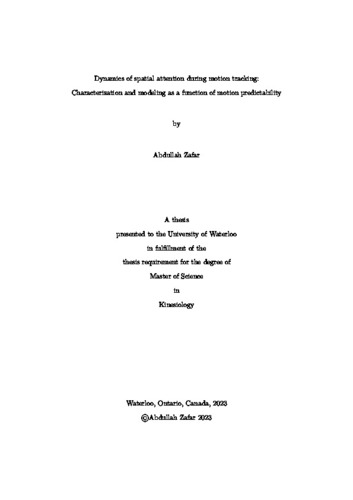| dc.description.abstract | Efficient information processing in ecological environments relies on spatial attention to selectively process relevant areas in the visual field. Attention has been shown to be biased ahead of simple, uniform target motion during smooth pursuit. However, real-world motion varies in predictability, and as such this study aimed to: a) determine how motion predictability affects attentional bias, b) characterize how visual attention adapts to changes in motion predictability, and c) implement a computational
model of visual attention during motion tracking.
Ten high-performance team sport athletes (5 male, 5 female) and ten healthy, young adults (5 male, 5 female) visually tracked a target moving at varying predictability levels. A probe was flashed ahead or behind target motion (2° or 6°), and manual response times (MRT) to probes were collected to indicate attention level. To investigate the temporal dynamics of attentional bias, a second tracking task was performed where the target changed predictability levels mid-trial. The effects of group, motion predictability, and probe distance, time & location on MRT bias were examined. Finally, a state-space model (input: target motion, output: attentional bias) was trained and tested on the motion tracking and MRT data using a 5-fold cross-validation.
MRT were significantly biased in athletes (distance=2°) and adults (distance=2°,6°) during predictable motion (p<0.01). There was no MRT bias for semi- and un-predictable motions. Furthermore, MRT bias took longer to accumulate, than it did to de-accumulate (p<0.01). Eye movements showed that catch-up saccades were larger (p<0.01) and more frequent (p<0.01) during unpredictable motion phases, and gradually reduced in size and frequency during sustained predictable motion. Cross-validation results demonstrated that the state-space model performance in predicting attentional bias had a mean absolute error of 18.6% (SD=0.04%).
In conclusion, the distribution of spatial attention during motion tracking is dependant on motion predictability, and the
accumulation of bias ahead of target motion takes longer than de-accumulation. These results indicate a conservative attentional allocation scheme that introduces bias based on predicted future errors in motion extrapolation. The state-space model developed based on these experimental results may extend existing dynamic saliency frameworks to factor in the effects of motion tracking on spatial attention. | en |

